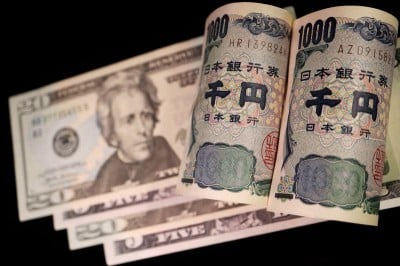Yen languishes as focus turns to Fed
 © Reuters. FILE PHOTO: Banknotes of Japanese yen and U.S. dollar are seen in this illustration picture taken September 23, 2022. REUTERS/Florence Lo/Illustration/File Photo DX +0.01% Add to/Remove from Watchlist Add to Watchlist Add Position
© Reuters. FILE PHOTO: Banknotes of Japanese yen and U.S. dollar are seen in this illustration picture taken September 23, 2022. REUTERS/Florence Lo/Illustration/File Photo DX +0.01% Add to/Remove from Watchlist Add to Watchlist Add Position Position added successfully to:
+ Add another position Close USD/CNH -0.06% Add to/Remove from Watchlist Add to Watchlist Add Position
Position added successfully to:
+ Add another position Close
By Tom Westbrook
SINGAPORE (Reuters) - The yen wobbled near 15-year lows on the euro and a one-year trough on the dollar on Wednesday, having slid on bets that a tweak of Japan's yield control policy isn't enough to close wide interest rate gaps that have pressured the currency for years.
Moves in early Asia trade were modest ahead of a U.S. Federal Reserve meeting later in the day - where rates are seen on hold - and the release of U.S. Treasury refunding details.
The New Zealand dollar slipped 0.4% to $0.5805 as softer-than-forecast employment data cemented expectations of an end to interest rate hikes.
Against the dollar, the yen fell about 1.7% overnight, touching a low of 151.74 - a whisker from the 151.94 level that prompted intervention a year ago. The yen breached 160 per euro for the first time since 2008.
It was last at 151.27 per dollar - down 13% for the year so far and 38% from its pandemic peak - and at 160.05 per euro.
Intervention remained high on investors' watch list, with Japan's top currency diplomat noting on Wednesday that recent moves seemed to be speculative, and that authorities were on "standby" to step in.
The Bank of Japan raised inflation forecasts on Tuesday, but not policy rates. It redefined its 1% limit on 10-year government bond yields as a reference rate, rather than a hard cap, effectively ending its strict yield-curve control policy.
Data from the finance ministry also showed Japan did not intervene in currency markets through October.
Taken together, it adds up to "no obvious new official approach to 'muscle' a stronger yen," so traders feel the coast is clear to take up short positions, said Alan Ruskin, macro strategist at Deutsche Bank.
"It is now more evident than ever, that a proper turn in dollar/yen is much less dependent on events in Japan than they are on the macro dynamic in the U.S," he said in a note.
On that score the dollar has been helped by the flattering comparison between the U.S. and other large economies. Data on Tuesday showed European growth a little softer than expected and a surprise slump in Chinese factory activity.
In the U.S. data showed wages and salaries rose solidly last quarter and while consumer confidence ebbed, it fell far less than markets had expected. The euro declined 0.4% on the dollar overnight and nursed losses at $1.0579.
The U.S. dollar index measure against a basket of major currencies rose 0.5% on Tuesday to 106.66. Sterling was steady at $1.2150. China's offshore yuan held at 7.34 per dollar amid a liquidity crunch in the onshore market that drove overnight repo rates as high as 50% as banks scrambled for month-end cash.
China's Caixin PMI data will be in focus later on Wednesday, ahead of U.S. manufacturing and private payrolls figures - before the Fed meeting.
U.S. yields rose in early Asia trade, while Japanese yields fell slightly on thin volumes, leaving the spread between benchmark 10-year rates at 398 bps. That is narrower than 414 bps it had hit in October.
"Nominal 10Y rate spreads now warrant dollar/yen a fair bit lower, i.e., 147-8," said James Malcolm, UBS currency strategist based in London.
"Though this relationship is becoming choppier, 10bp has been roughly equivalent to one big figure in spot over the last couple of years."

